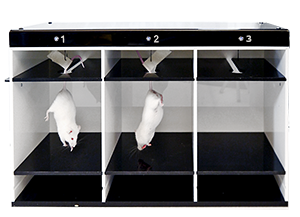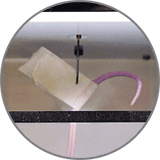
The Contextual Kits for T2CT have been designed to enhance thermal place preference studies...

The Contextual Kits for T2CT have been designed to enhance thermal place preference studies...
Discover our products
An easy way to objectively quantify the muscular strength of mice and rats, and to assess the...
Discover our products
The BIOSEB Spontaneous Activity Wheel offers an effective solution for quantifying rodent...
Discover our products
The BIOSEB Spontaneous Activity Wheel is an easy way to quantify rodent voluntary activity in...
Discover our products
The uncomplicated way to monitor rodent activity over several days from their home cage...
Discover our products
These small animal treadmills are used for forced exercise training and accurate testing of...
Discover our products
For testing animal's thermal sensitivity to pain resulting from exposure to heat or cold: the...
Discover our products
An operator independent test to study pain thresholds in rodents (mouse and rat) by assessing...
Discover our products
New and improved! The operator-independent Thermal Gradient Test used to show favorite...
Discover our products
The Contextual Kits for T2CT have been designed to enhance thermal place preference studies...
Discover our products
The advanced version of our Dynamic Weight Bearing Test for rodents (rats and mice) allows for...
Discover our products
An easy and non pain-inducing solution for assessing the level of discomfort (incapacitance) in...
Discover our products
A unique device that provides automated measurement of weight bearing and force distribution...
Discover our products![Dynamic Weight Bearing 2.0 – Postural Module [Add-on]](https://bioseb.com/733-home_default/dynamic-weight-bearing-20-add-on-postural-module.jpg)
Expand Your Analysis with Advanced Postural and Locomotor Calculations BIOSEB’s renowned...
Discover our products
A quick solution to determine the mechanical sensitivity threshold in rodents (mice and rats)....
Discover our products
As an electronic version of the classical Von Frey Filaments esthesiometer (or aesthesiometer),...
Discover our products
New ROBUST and modular cages to gently hold rodents (rats or mice) during nociceptive and...
Discover our products
An economical and versatile solution for when flexible quantitative sensory testing (QST) is...
Discover our products
Dedicated to small animals, like mice and rats, Smalgo is a pressure-based analgesimeter...
Discover our products
Bioseb's version 5 of the Tail Suspension Test system, based on both strain sensors and video...
Discover our products
NEW ! A complete (hardware + software), dedicated and automated solution for the Elevated Plus...
Discover our products
A unique setup for the automation of the Open Field test for rats and mice : 3D-camera based...
Discover our products
Open-field test - ARENA ONLY - used to evaluate of animal's basal activity and its evolution for...
Discover our products
The new Forced Swimming Test system from Bioseb uses a dual approach: Combining a double input...
Discover our products
A brand new innovative setup for the automation of the Novel Object Recognition Test : 3D-camera...
Discover our products
Open-field test - ARENA ONLY - used to evaluate of animal's basal activity and its evolution for...
Discover our products
An entirely modular experimental enclosure designed to conduct operant conditioning procedures...
Discover our products
A standard experimental chamber for automated or manual assessment of conditioned place...
Discover our products
Real-Time Physiological Monitoring for Small Animals – Wireless & Non-Invasive The Bioseb...
Discover our products
The ETH-401 is a bridge amplifier for various transducers that provides four channels of...
Discover our products
The IX-118 is a fast 100 Khz, high-resolution data acquisition system suitable for most data...
Discover our products
The ETH-256 is a 2 channels high performance, general-purpose life science research amplifier,...
Discover our products
Full-featured multi-channel stimulator for neuromuscular stimulation
Discover our products
Discover BIO-FOODIS, the next generation solution for understanding animal feeding behavior with...
Discover our products
The OXYLET system - Physiocage is a modular system allowing the integration of respiratory...
Discover our products
Innovative and appropriate equipment for measuring food/liquid consumption and correlated motor...
Discover our products
An economical, high performance Oxygen and Carbon Dioxide Analyzer with sampling rates fast...
Discover our productsBioseb's version 5 of the Tail Suspension Test system, based on both strain sensors and video acquisition, is the only fully automatic solution in the world for running a simple and objective despair test on mice. It is a fast, painless, and reliable way for testing psychotropic effects from stimulant doses of drugs such as anti-depressants and sedatives. This classic and painless research test for anxiety and depression is now offered with a new, powerful and modern software, in a wireless, bluetooth-based version.
![]()

![]() Presentation
Presentation
The tail-suspension test was developed as an alternative to the Porsolt Forced Swimming test, and is based on a similar concept. Mice, suspended by their tail using a piece of tape (a painless method), innately attempt to escape from this adversive situation. However, following failed attempts to escape, they experience a kind of despair and become immobile. The magnitude of immobility is considered to be correlated with the depressive-like state of the subjects and is significantly decreased by antidepressants. The Tail Suspension Test was described in the 80's by Steru & al. and allows for fast evaluation of drugs' (anti-depressants, sedatives) psychotropic effects, making it a classic and painless research test for anxiety and depression.
BIOSEB' Tail Suspension Test system is the only full automatic test in the world!. It is based on the original “ITEMATIC-TST” described by Steru in 1987, it uses both strain gauges and video backup recording, and does not induce any pain in the animal: the mouse’s tail is simply stuck to the sensor using a piece of tape.
The original ITEMATIC design has been modified, adapted and improved for the Porsolt and Partners Pharmacology Co in the 2000. It can hold 3 mice in three separate compartments and features adjustable floor height and anti climbing plates for C57 strain mice.
The Bioseb Tail Suspension Test instrument offers unique features such as the randomization process of the animals, the measurement of up to 6 animals in the same run, the direct computations of the 'Immobility', the 'Energy' and the 'Power in Motion'. Settings are available to adjust the definitions to the user's protocol. The energy value is a unique way to differentiate between passive swinging and active struggling. The power in motion is an additional discriminating calculation that gives an indication of the strength of the mice.![]() How does it work?
How does it work?

The measuring principle is based on the quantity of movements that a mouse trying to escape from its suspension can generate. During the Tail Suspension Test, the movements of the mice are analyzed in terms of activity (active/non active), energy and power developed over time. As human observation is time consuming and tedious, Bioseb's Tail Suspension Test (TST) automates the entire experiment.
The operator prepares his pieces of tape to suspend mice and the home cages with mice to be tested. When the whole experiment has been setup in the software and the list of animals randomized, the operator suspends each single mouse according to the randomization shown on the screen. Each channel is started individually by pressing a specific key on the computer so that each mouse is suspended the same amount of time (something impossible with a system based solely on video).
When the run is finished, mice are removed and the operator is prompted to suspend the next batch of mice. After the experiment, the whole batch can be analyzed and statistics on averages minimums, maximums and standard deviations are computed in seconds as is individual performance. Data is also presented within minutes for both the groups and individual animals (mice).
The TST-SOFT generates graphics that can be exported as a bmp image for further presentations.
![]() Supplied with
Supplied with
• One or two sets of three cages together with power supplies and USB cables as needed.
• 1 software license (USB dongle with product ID tag)
• Optional HD USB camera and its tripod and USB cable
Data sheet
Number of publications:
NEW ! A complete (hardware + software), dedicated and automated solution for the Elevated Plus Maze test, featuring...
A unique setup for the automation of the Open Field test for rats and mice : 3D-camera based technology is now capable of...
Open-field test - ARENA ONLY - used to evaluate of animal's basal activity and its evolution for rodents (rats and mice) in...
check_circle
check_circle